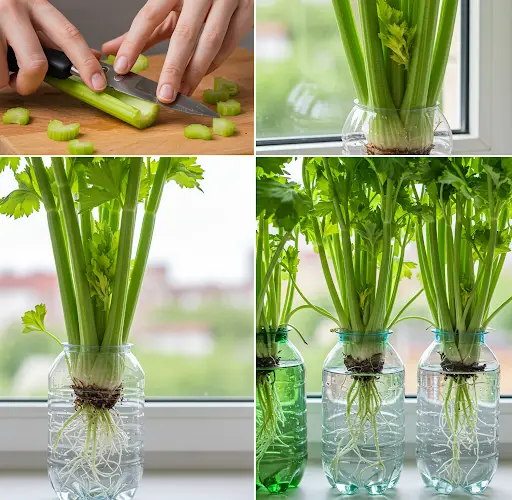Many people assume you need a backyard or rich garden soil to grow fresh vegetables—but that couldn’t be further from the truth. With just a few everyday materials and a little creativity, it’s entirely possible to grow an abundance of celery at home—even if you have no soil and no traditional garden space.
This is the story of how, with limited resources, it became possible to grow healthy, crisp celery year-round using simple hydroponic and recycled setups. This method works great for people living in apartments, urban areas, or any space where outdoor gardening isn’t an option.
Why Celery?
Celery is one of the most nutritious vegetables to grow at home. It’s packed with fiber, antioxidants, and essential vitamins like A, C, and K. However, it can be expensive in stores and tends to spoil quickly in the fridge.
By growing it yourself—even without soil—you can enjoy fresh celery straight from your windowsill or balcony, cut only when you need it. The taste is crisper, the stalks are more flavorful, and there’s less waste.
Materials Used (No Soil Required)
Here’s how to start celery cultivation without any garden or soil:
-
Celery base from store-bought bunches (the bottom root part)
-
Shallow containers or recycled plastic trays
-
Clean water (tap water works if it’s not heavily chlorinated)
-
Cotton, paper towels, coconut coir, or hydroponic sponges
-
Optional: Nutrient solution (or diluted compost tea)
No garden? No problem. A sunny windowsill, balcony, or even a kitchen counter with natural light will do just fine.
Step-by-Step: Regrow Celery from Scraps
1. Prepare the Celery Base
After using celery stalks in your cooking, save the base—the round part where all stalks connect. Rinse it and trim the bottom slightly to expose fresh tissue.
2. Soak in Water
Place the base in a shallow container with about 1–2 cm of clean water. Make sure only the bottom touches the water while the top stays dry.
Place the container in a well-lit spot with indirect sunlight (a window or balcony is perfect). Within 3–5 days, you’ll see small green shoots emerging from the center.
3. Add a Growing Medium (Optional)
For better root development, transfer the base to a container lined with moist cotton, coconut coir, or even paper towels. This helps stabilize the plant and encourages stronger roots without needing soil.
Keep the medium moist by misting it or adding small amounts of water daily. Be careful not to flood the base—too much water can cause rot.
4. Provide Nutrients
Once the shoots are 5–7 cm tall and roots begin to form, add a mild nutrient solution to the water every 7–10 days. You can use store-bought hydroponic nutrients or make a natural solution at home using:
-
Banana peel water (rich in potassium)
-
Diluted fish emulsion
-
Compost tea
This step isn’t mandatory, but it helps the celery grow taller, firmer stalks faster.
How to Grow More: Vertical and Bottle Setups
To multiply your harvest, use vertical setups or plastic bottle gardens. Here’s how:
-
Cut plastic bottles in half and use them as planting containers.
-
Insert cotton or coconut coir as a moisture-holding medium.
-
Place the celery base inside and keep it moist.
-
Stack or hang the bottles vertically using wire or shelves.
This method allows you to grow multiple celery plants in a tiny space—and harvest throughout the year.
Maintenance and Harvesting
-
Lighting: Celery needs at least 4–6 hours of indirect sunlight daily. If you’re indoors, use LED grow lights to supplement.
-
Watering: Keep the medium moist, but avoid standing water.
-
Feeding: Feed lightly every 10 days with nutrient solution.
You can start harvesting when the stalks reach about 15 cm tall. Use scissors to snip off outer stalks as needed, leaving the inner ones to keep growing. This way, your plant continues producing fresh celery over several weeks.
Benefits of Growing Celery Without Soil
-
Zero soil needed – no mess, no digging
-
Great for beginners and kids
-
Uses kitchen scraps—nothing wasted
-
Space-saving vertical options
-
Low cost and highly sustainable
It’s also an excellent choice for those who want to eat healthier, avoid chemicals, and gain more control over their food source.
Final Thoughts
If you’ve ever said, “I can’t grow vegetables—I don’t have space or soil,” it’s time to change that mindset. With this simple, soil-free method, anyone can grow crisp, flavorful celery—even on a windowsill.
Using basic materials like kitchen scraps, plastic bottles, and clean water, you can create a mini garden that yields fresh celery all year long. Whether you’re in a high-rise apartment or just experimenting with home gardening, this method offers a fun, efficient, and surprisingly productive way to bring fresh greens into your life.



